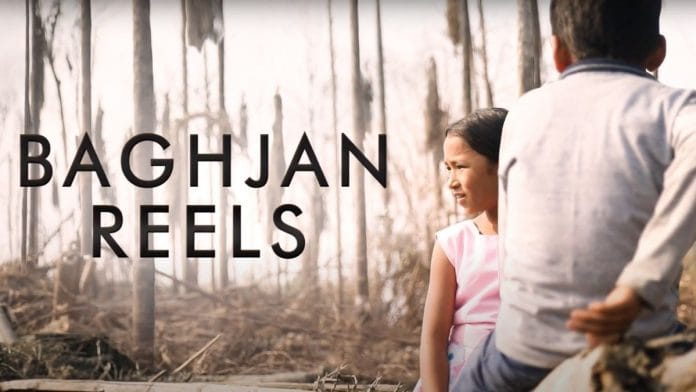In 2020, while the rest of the world battled the pandemic, the village of Baghjan in Assam had another scarring tragedy on its hand — the longest oil well fire in the history of India. And now there’s a documentary film on it to make sure we don’t forget.
Located about 17 km from Doomdooma town in Tinsukia district of Assam, Baghajan’s sustenance, like most other villages in the state, is based on its land and water, on agriculture and fishing. But the fire that started on 27 May 2020 and was finally put out on 15 November left a mark well beyond a year — it contaminated everything.
In Baghjan Reels, a documentary that probes the environment versus development debate vis-a-vis the oil well fire incident, Tahin Ojah goes back to the inexpungible trauma her homeland suffered, since nobody seemed to care anymore.
“I visited the place two months after the fire was put out. You could still smell oil everywhere. It felt like if I dropped a lit matchstick, the whole place would erupt in flames,” says Ojah.
The documentary filmmaker, who was born and brought up in Guwahati and is a creative director in Mumbai, self-financed the project, which is free to watch on YouTube.
Also Read: How villagers in Assam’s Baghjan are rebuilding lives after 5-month-long oil well fire
The fire that could not be put out
The oil leak in Baghjan failed to get the kind of coverage, or capture the attention, the same way the Visakhapatnam gas leak received that year. The chemical leak from the LG Polymers plant in the city on 7 May killed at least seven people and triggered panic in the industrial coastal city. Many compared it to the 1984 Bhopal gas tragedy.
Oil India Ltd. was drilling a well at Baghjan, which led to a massive blowout at around 1:45 pm on 27 May 2020. Natural gas and oil particles began to gush out uncontrollably from the blowout site. The resultant tragedy is etched forever in the history of oil fires and the State-owned company.
But the immediate impact it had on the villagers of Baghjan, some of whom were drenched in oil while trying to escape from the explosion, is not spoken about. Human suffering cannot simply be reduced to data, and Baghjan Reel looks into the lives behind the ‘data’ presented in the media.
Also Read: Burnt homes, illnesses, damage to ecology — what Baghjan is left with months after OIL fire
Tipping point
Villagers who were evacuated to relief camps now complain of the residual effects of the fire like anxiety, damage to their ears and respiratory illnesses. Hundreds of unidentified victims, who live burdened with the memory of the inferno continue, despite the trauma, to fight for compensation and justice. According to Ojah, only around 12 households have received some compensation so far.
The damage, however, extends far beyond skin and bones. It has also altered the landscape of the Maguri-Motapung wetland and Dibru-Saikhowa National Park on the banks of the Dibru river that has sustained not only local communities but also 110 species of birds, located next to the blowout site, forever.
Rehabilitation may be underway, but as with most post-disaster situations, restorative processes are still absent. Baghjan Reel captures the ‘post-event’ moments when the news vans have left, and the fire is put out, and it becomes a forgotten land that no one cares about, except OIL because it is obligated to compensate the villagers.
“There was a woman who refused to talk to me because she was convinced I will sell whatever I am capturing and make money out of the tragedy,” Ojah says. Even Discovery’s two-part series Inside the Burning talks more about what OIL did, rather than what the villagers are now facing.
From criminal cases to litigation demanding compensation, OIL is facing a lot of heat. It is addressing the concerns, but that is also a given, considering it was operating in the area without mandatory clearances, as illustrated by an NGT report.
Baghjan Reel takes us through the lives of the people who continue living in Baghjan after the oil well was abandoned by OIL. The 34-minute-long documentary incorporates footage shared online during the blowout, and the testimonials of villagers, OIL representatives and environmental activists. The interspersing of then and now moments build up the narrative of how life has changed forever for the inhabitants of the place.
Also Read: Bhopal disaster: Documents show how India & Union Carbide denied victims their due
Cost of ‘development’
Scenes from Baghjan Reels show cattle still drinking from oil-laced water and crops refusing to grow on scorched soil. The few who remain are struggling to pick up pieces, as the world, India and even other places in Assam erase them from its memory.
The rate of development in the Northeast is obviously slow. What is sold by politicians and corporations alike is “development hobo” (There will be development). In a region where every year, people have to leave to other cities in India for higher studies or jobs, development is a big lure.
Villagers were promised development, through the establishment of oil wells and jobs. But only two people from Baghjan have got jobs so far after the oil well tragedy. People have deserted their homes to go to neighbouring cities like Tinsukia.
If you are interested in news and voices from the Northeast and wish to know more about what happened in Baghjan, the documentary is a good place to start. Made by an Axomiya, it provides a space for the affected voices to speak up, and tell their own stories, without being hijacked by the narrative of the ‘mainland’.
Views are personal.
(Edited by Srinjoy Dey)






